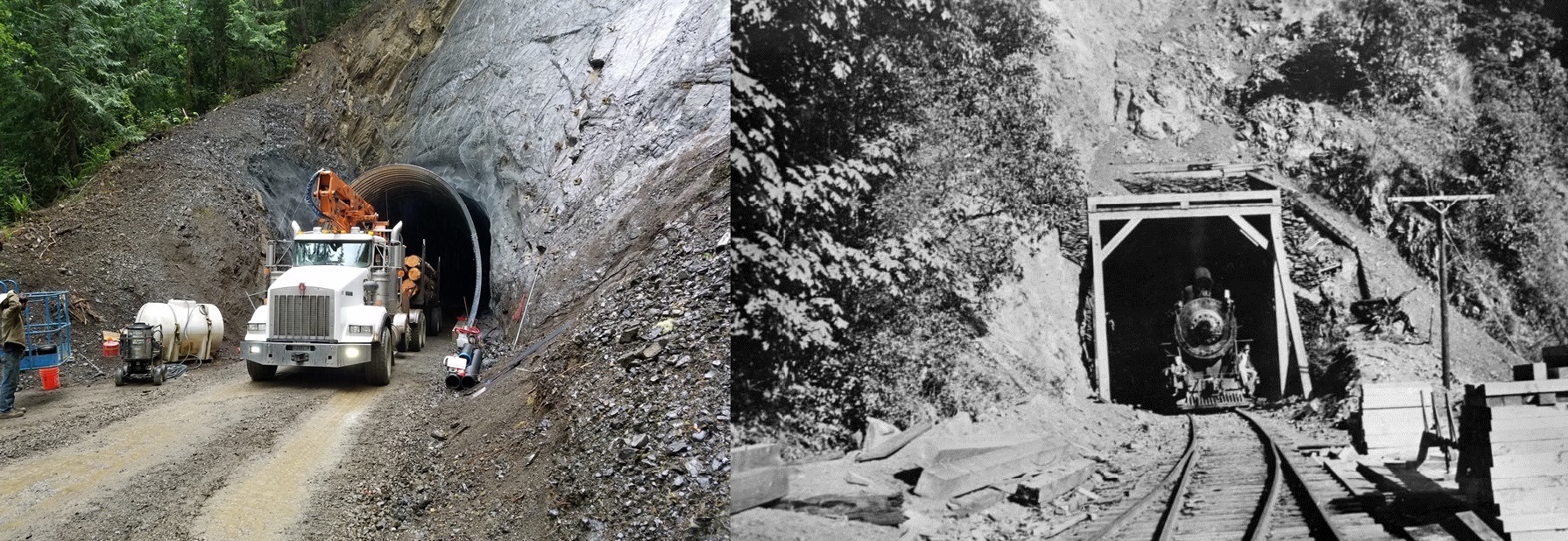|
You are viewing ARCHIVED content published online before January 20, 2025.
Please note that this content is NOT UPDATED, and links may not work. For current information,
visit https://www.nps.gov/aboutus/news/index.htm.

D. Brouillard/FHWA and historic photograph of the McFee Tunnel courtesy of the Bert Kellogg Collection of the North Olympic Library System
Contact: Penny Wagner, 360-565-3005 PORT ANGELES, WA: The last load of logs was hauled through the McFee Tunnel on the Spruce Railroad Trail (SRRT) and will be used for a radically different purpose than the intention of the historic Spruce Railroad. A side-by-side comparison of the recent and historic photographs of the McFee Tunnel offers an opportunity to pause and reflect; to look back on the ride along the track of time and forward down the line ahead.Nearly 100 years after the railroad was built with the intention of logging and transporting lumber for the war effort, trees are now removed to improve the SRRT and provide universal accessibility. Today, the railroad grade is part of Olympic National Park and the SRRT is a piece of the 134- mile long Olympic Discovery Trail which will eventually connect Port Townsend to La Push—Puget Sound to the Pacific Ocean. The trees removed from sections of the SRRT, some complete with root wads, have been utilized by the park to preserve fish habitat in road damage repairs along rivers throughout the park. The removal of trees to provide for visitor access was very selective and went through analysis to mitigate impacts to the environment. The logs were used in park road repairs on Olympic Hot Springs Road, Graves Creek Road, Quinault North Shore Road and eventually on the Hoh Road. The placement of rip rap to armor road banks along water ways, a prevalent practice throughout the 20th century, inadvertently diminished fish habitat. Traditional bank protection methods tended to create a smooth, hard surface along the bank which increased water velocities and simplified the stream channel. New bank stabilization methods employ the use of large logs with root wads intact and other native materials to create a roughened, complex surface to lessen the impact on fish habitat. Wood can also be used to create structures to mimic natural fish habitat where it has been lost due to past practices. In 1918, the need to harvest and transport aircraft-quality spruce for bi-planes in World War I led to the construction of the Spruce Railroad. The railroad was almost complete in the fall of 1918, but the end of World War I in November meant the end of the operation and no Sitka spruce were ever processed at the local mills for bi-planes. The railroad was purchased from the government and utilized as a common-carrier line and logging railroad after the war until it was abandoned in 1951. Today, the SRRT is in the fifth phase of a multi-year collaborative project to establish the entire 9.5 mile length of the trail as a universally accessible, multipurpose trail to be shared by hikers, bicyclists, equestrians and people traveling in wheelchairs. This phase, to be completed in the next few weeks, includes construction of an additional half-mile section of 12'-wide universally accessible trail as well as restoration of the 450-foot long McFee Tunnel. The contract also includes demolition and removal of a park-owned structure to allow for construction of a new 33-car parking lot with additional parking for oversized vehicles and a horse trailer turn-around at the Lyre River Trailhead. The eastern portion of the SRRT from the Lyre River Trailhead is closed with no access to Devil’s Punchbowl. The western section of trail beyond the Camp David Jr. Road Trailhead is open for a few miles to just west of Devil’s Punchbowl. Both tunnels are currently closed to pedestrians. This phase of improvements, including the McFee Tunnel, will be open to the public in mid-July. Additional work to improve the SRRT is planned for late 2017 and 2018, with completion anticipated in late 2019. For current trail, road and travel information, visitors should consult the park website at www.nps.gov/olym or call the recorded Road and Weather Hotline at 360-565-3131. Photo credit for the historic photograph of the McFee Tunnel courtesy of the Bert Kellogg Collection of the North Olympic Library System. --NPS--
About the National Park Service. More than 20,000 National Park Service employees care for America’s 417 national parks and work with communities across the nation to help preserve local history and create close-to-home recreational opportunities. Learn more at www.nps.gov. |
Last updated: June 28, 2017
